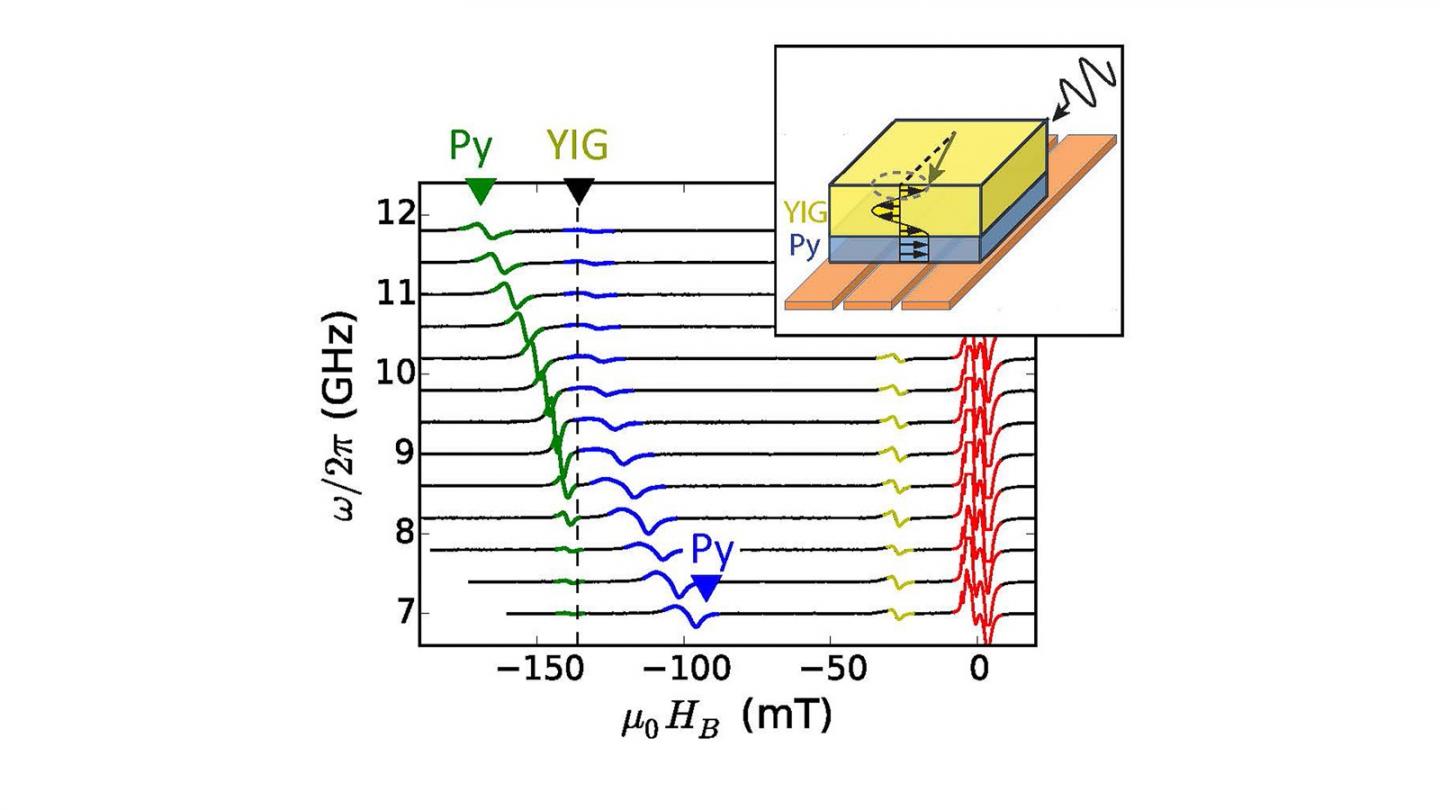
Credit: Argonne National Laboratory
Like fans that blow in sync, certain magnetic materials can exhibit interesting energetic properties.
In order to find new ways to transmit and process information, scientists have begun to explore the behavior of electronic and magnetic spins, specifically their resonant excitations, as information carriers. In some cases, researchers have identified new phenomena that could help eventually inform the creation of new devices for spintronic and quantum applications.
In a new study led by the U.S. Department of Energy’s (DOE) Argonne National Laboratory, researchers have uncovered a novel way in which the excitations of magnetic spins in two different thin films can be strongly coupled to each other through their common interface. This dynamic coupling represents one kind of hybrid system that is getting increasing amounts of attention from scientists interested in quantum information systems.
“For quantum information systems, the name of the game is to take some excitation and to manipulate it in some way or transfer it to another excitation, and that’s pretty much at the heart of what we’re doing here.” — University of Illinois materials scientist Axel Hoffmann
“One way to think about it is as though you have two pairs of masses attached to springs,” said Argonne postdoctoral researcher and first author Yi Li. “We know that each mass connected to a spring will oscillate periodically when it’s hit from the outside. But if we connect the two masses with a third spring, then the oscillation of one mass will also trigger the oscillation of the other mass, which can be used to exchange information between the springs. The role of the third spring here is played by the interfacial exchange coupling between the two magnetic layers.”
With some smart engineering, researchers can set the free oscillation frequency of the two layers of magnetic spins — the “masses” — to be identical, where they are the most favorable to couple. In addition, they show that the two systems can be “strongly” coupled, a state which is important to maintain coherence and may inspire applications in quantum information.
Besides the strong-coupling state, researchers have found an additional new effect in the magnetic bilayer which has an impact on the coherence of their excitations: one side can pump energy, called spin current, into the other one. One notable and intriguing behavior concerning the new dynamic coupling involves the exchange of energy between the two layers in the magnetic material.
According to University of Illinois materials scientist and study author Axel Hoffmann, each layer has a particular length of time over which the magnetization dynamics will usually independently persist. However, with the introduction of the spin current pushing spins in a particular direction, there can be enough energy transferred so that the magnetization dynamics last substantially longer in one of the layers.
“We knew that a rigid kind of coupling existed, but the fact is that the other dynamic coupling is also important — and important enough so that we can’t neglect it,” Hoffmann said. “For quantum information systems, the name of the game is to take some excitation and to manipulate it in some way or transfer it to another excitation, and that’s pretty much at the heart of what we’re doing here.”
“There is an intrinsic magnetic interaction that couples these two layers,” Li added. “We can apply a magnetic field, and then we can determine whether these two layers are pumping in phase or out of phase. Such controlled interactions are in principle what people are doing for quantum information processing.”
According to Hoffmann, the experiment started with the identification of two magnetic systems that the researchers knew were coupled together. By seeking to make the coupling as strong as it could possibly be compared to the individual excitations in the material, the researchers were able to see the additional detail of how the spin pumping energy transfer came about.
###
A paper based on the study, “Coherent spin pumping in a strongly coupled magnon-magnon hybrid system,” appeared in the March 17 issue of Physical Review Letters. Other authors of the study included Argonne’s Zhizhi Zhang, Jonathan Gibbons, John Pearson, Valentine Novosad, and Wei Zhang; Paul Haney, Mark Stiles, and Vivek Amin of the National Institute of Standards and Technology; Wei Cao and William Bailey of Columbia University; and Joseph Sklenar of Wayne State University.
The Argonne portion of the research was funded by the DOE‘s Office of Science.
Argonne National Laboratory seeks solutions to pressing national problems in science and technology. The nation’s first national laboratory, Argonne conducts leading-edge basic and applied scientific research in virtually every scientific discipline. Argonne researchers work closely with researchers from hundreds of companies, universities, and federal, state and municipal agencies to help them solve their specific problems, advance America’s scientific leadership and prepare the nation for a better future. With employees from more than 60 nations, Argonne is managed by UChicago Argonne, LLC for the U.S. Department of Energy’s Office of Science.
The U.S. Department of Energy’s Office of Science is the single largest supporter of basic research in the physical sciences in the United States and is working to address some of the most pressing challenges of our time. For more information, visit https:/
Media Contact
Diana Anderson
[email protected]
Original Source
https:/
Related Journal Article
http://dx.





